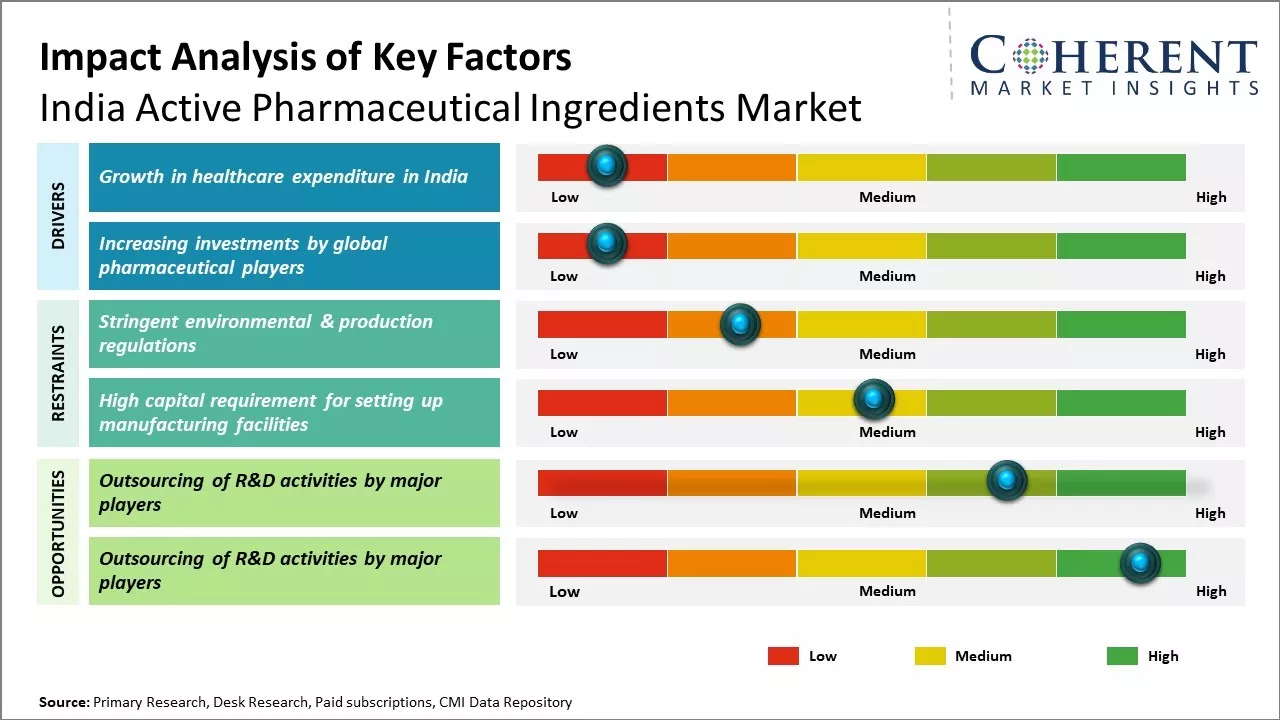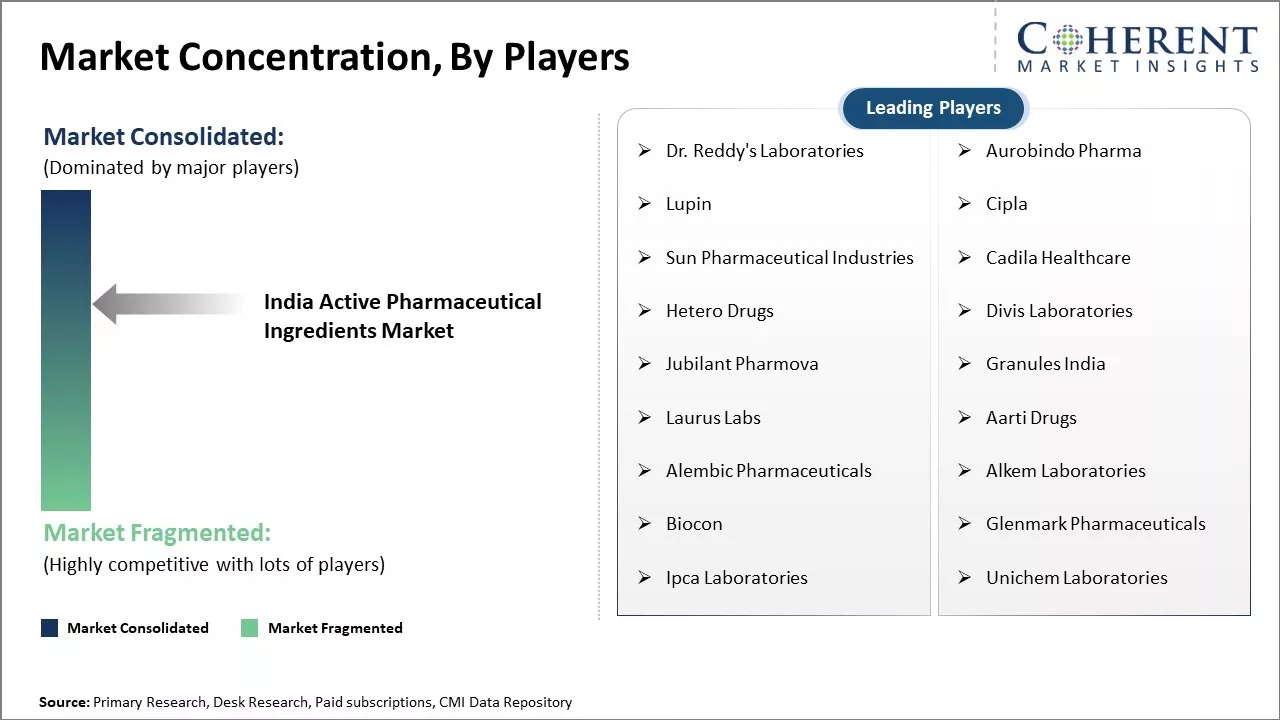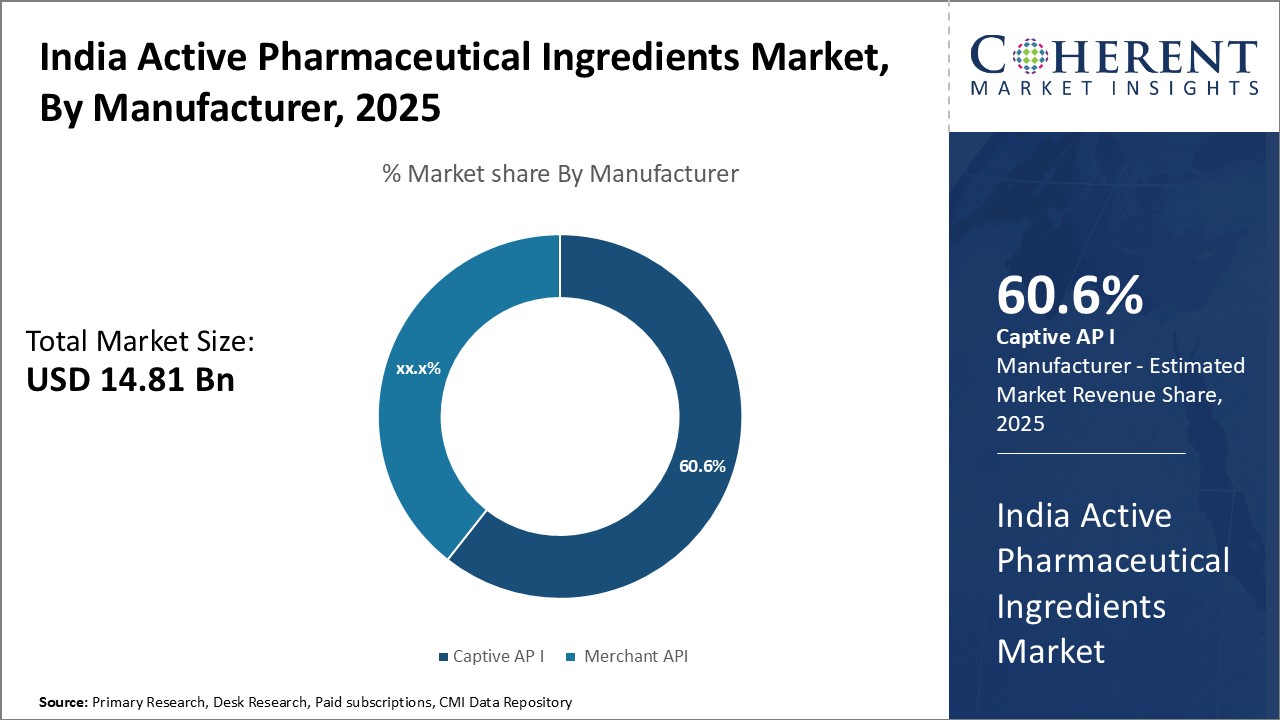India active pharmaceutical ingredients market is estimated to be valued at USD 14.81 Bn in 2025 and is expected to reach USD 25.23 Bn by 2032, exhibiting a compound annual growth rate (CAGR) of 7.9% from 2025 to 2032.

Discover market dynamics shaping the industry: Download Free Sample
There has been huge demand for generic drugs in the country. The government has also taken initiatives to promote local manufacturing like launching the 'Pharmaceuticals Vision 2020' and coming up with Production Linked Incentive (PLI) schemes. This has attracted global pharmaceutical players to partner with local API manufacturers or set up manufacturing units in India. Indian players have enhanced their capabilities to cater to international markets and meet stringent quality standards. The country accounts for around 30% of global exports of generic medicines. This trend can make India a global API manufacturing hub.
Growth in healthcare expenditure in India
With rapid economic growth and rising incomes, healthcare expenditure in India has increased significantly over the past decade. Various government initiatives aim to expand healthcare access for citizens and provide universal healthcare. The government's Ayushman Bharat program is one of the largest publicly funded healthcare systems in the world. This will enable people to avail cashless healthcare services and treatments. As more people gain insurance coverage and have ability to pay, there will be huge demand for pharmaceutical products. The program along with other state-led health insurance schemes are expected to boost consumption of medicines for chronic as well as acute ailments. This can boost demand for active pharmaceutical ingredients, which forms the key raw material input for drug manufacturing. Due to rising awareness about benefits of timely treatment increases, preventive healthcare is gaining traction. This can increase offtake of generic as well as patented drugs in the country.

Get actionable strategies to beat competition: Download Free Sample
Increasing investments by global pharmaceutical players
India has emerged as one of the leading locations for active pharmaceutical ingredients (API) production globally. The country accounts for 20% of total global antiretroviral drug production. It is the largest provider of generic medicines worldwide, with the Indian generics accounting for 20% of global exports. Seeing strong growth prospects and affordable skilled labor, many large multi-national pharmaceutical companies have significantly ramped up investments in India over the past few years.
These have set up advanced API manufacturing facilities as well as research & development centers to cater to domestic as well as international markets. Leading players like Dr. Reddy's, Aurobindo Pharma and Sun Pharma are undertaking massive capacity expansion projects. This enables companies to increase scale as well as integration along the pharmaceutical value chain within the country. Growing investments can expand domestic API production capabilities as well as boosts technology upgrades. This attracts even more investments, creating a positive cycle that benefits development of the Indian pharmaceutical industry. Increased investments coupled with cost competitiveness can make India an essential global API supplier.
Key Takeaways from Analyst
India active pharmaceutical ingredients market growth is driven by rising generic drug manufacturing and increasing domestic and export demand for APIs. India already supplies over 30% of global demand for generic medicines and its API exports have been steadily rising. However, supply chain disruptions caused due to COVID-19 pandemic related lockdowns could hamper the market growth. The southern region of India dominates the market, led by Telangana, Karnataka and Kerala states. Given initiatives to boost pharmaceutical manufacturing, we expect other regions like west and north to catch up faster. The government's production linked incentive (PLI) scheme for bulk drugs and medical device parks being set up across different states could aid this dispersal. Meanwhile, China's growing regulatory scrutiny on environmental compliance may help divert some global API sourcing to reliable alternative hubs like India.
Key players are investing aggressively in capacity expansions as well as research and development of complex APIs to move up the value chain. This includes developing capabilities for fermentation based and hormonal APIs, which currently have higher import dependence. The increased focus on self-sufficiency in APIs as well as more exports can offer market growth opportunities. However, rising compliance costs and lack of technologies for high-end APIs can hamper the market growth.
Market Challenges: Stringent environmental & production regulations
Stringent environmental and production regulations by the Government of India can hamper the India active pharmaceutical ingredients market growth. The API manufacturing industry has come under increased regulatory scrutiny over the past few years due to serious environmental concerns related to pollution and dump of hazardous chemicals. A key development in this regard has been the notification of more stringent guidelines for API units located in industrial clusters under National Green Tribunal in 2020. As per these guidelines, industries are required to install effluent treatment plants to treat industrial waste before discharging into water bodies. These also need to ensure proper treatment and disposal of hazardous solid waste as per the Hazardous and Other Wastes (Management and Transboundary Movement) Rules, 2016. Compliance to these regulations requires significant capital investments and operating costs for upgrading existing infrastructure and installing emission control equipment. This has forced several small and medium API units lacking finances to either shut down or relocate to other less regulated areas. The regulatory framework for approvals and compliance has also been made more complex and time-consuming with the introduction of new guidelines. For instance, obtaining consent from State Pollution Control Boards involving approval of plans for wastewater treatment and disposal along with emission standards now requires 9-12 months compared to 3-6 months earlier. This leads to delays in setting up of new production facilities or expansion of existing ones. Furthermore, frequent changes in Good Manufacturing Practices (GMP) standards by regulatory authorities like the Food and Drug Administration in India necessitate upgrades and incremental investments.
Market Opportunities: Outsourcing of R&D activities by major players
Outsourcing of research and development activities by major pharmaceutical players provides a huge opportunity for India active pharmaceutical ingredients market growth. As labor costs in traditional pharma hubs like U.S. and Europe continue to rise steadily, India has emerged as an attractive destination for outsourcing R&D functions due to availability of low-cost, high quality skilled workforce. Indian contract research and manufacturing organizations have built robust capabilities across the entire drug development life cycle from discovery and pre-clinical testing to formulation development and clinical trials. Leading pharma companies are leveraging India's strengths to conduct a larger share of their basic research activities including target validation, hit identification and lead optimization studies. For example, according to data from India Brand Equity Foundation, foreign research collaborations by Indian CROs and biotech firms had increased by 25% from 2020 to 2021 with major partnerships unveiled with U.S. and European pharmaceutical majors. In addition to cost benefits, outsourcing R&D to India provides global drug makers access to a large talent pool of scientific professionals. India produces over 50,000 science and technology graduates annually, according to India's National Science and Technology Management Information System. Pharmaceutical outsourcing in India is also supported by a strong intellectual property rights framework and global quality certifications held by many domestic service providers. As costs in traditional pharma centers continue rising and pressure builds to cut drug development timelines, outsourcing to India can play an even more strategic role in global pharmaceutical innovation in the near future. This widespread outsourcing is likely to catapult India's position as a leading API supplier.

Discover high revenue pocket segments and roadmap to it: Download Free Sample
By Manufacturer - Security of supply drives captive API segment growth
In terms of manufacturer, captive API segment is expected to contribute the highest market share of 60.6% in 2025, owing to their ability to ensure security of supply for their parent companies. Captive facilities are fully owned by pharmaceutical companies and focus on production of core molecules required for the companies' important drugs and formulations. This vertical integration enables the pharmaceutical businesses to secure uninterrupted supply of critical APIs even during periods of shortages or supply chain disruptions in the market. It also provides them greater control over manufacturing standards and quality consistency compared to outsourcing to third party suppliers. Many Indian drug makers have made large capital investments over the years to establish extensive in-house API manufacturing capabilities aimed at enhancing self-reliance. The captive model helps minimize reliance on imported or contracted APIs and reduces exposure to volatility in external supplier markets.
By Synthesis Type - Cost advantage drives synthetic segment growth
In terms of synthesis type, synthetic segment is expected to contribute the highest market share of 52.5% in 2025, owing to the inherent cost benefits of synthetic routes of production. A majority of commonly used APIs are small molecule compounds that can be conveniently synthesized through chemical reactions. This allows for mass production of such generic APIs at economical prices using optimized manufacturing processes. The capital expenditure and skill requirements for setting up synthetic API units are also relatively lower compared to biotech facilities. Considering the price-sensitive nature of the domestic formulation market, pharmaceutical companies favor synthetic APIs that allow production of low-cost generic drugs. Process innovation can reduce production costs of various synthetic molecules. These cost advantages will likely sustain synthetic APIs' competitive edge over biotech alternatives.
By Drug Type - Accessibility drives branded segment growth
In terms of drug type, branded segment is expected to contribute the highest the highest market share of 51.5% in 2025, owing to greater accessibility of such products to patients. In the Indian pharmaceutical landscape, branded formulations account for the major portion of retail pharmaceutical sales. This can be attributed to various factors such awareness and recognition of branded products, established sales and distribution networks of leading companies, and prescribing habits of physicians. The marketing strength of large pharma players who promote their brands aggressively among doctors and consumers plays a crucial supportive role. Additionally, a considerable population lacking health insurance still prefers paying directly for trusted branded drugs over lower-priced generics. Such patients view branded products as more reliable in terms of efficacy and safety. These accessibility-related factors ensure the stickiness of branded drugs in the market.
India Active Pharmaceutical Ingredients Market Report Coverage
| Report Coverage | Details | ||
|---|---|---|---|
| Base Year: | 2024 | Market Size in 2025: | USD 14.81 Bn |
| Historical Data for: | 2020 To 2024 | Forecast Period: | 2025 To 2032 |
| Forecast Period 2025 to 2032 CAGR: | 7.9% | 2032 Value Projection: | USD 25.23 Bn |
| Geographies covered: |
|
||
| Segments covered: |
|
||
| Companies covered: |
Dr. Reddy's Laboratories, Aurobindo Pharma, Lupin, Cipla, Sun Pharmaceutical Industries, Cadila Healthcare, Hetero Drugs, Divis Laboratories, Jubilant Pharmova, Granules India, Laurus Labs, Aarti Drugs, Alembic Pharmaceuticals, Alkem Laboratories, Biocon, Glenmark Pharmaceuticals, Ipca Laboratories, and Unichem Laboratories |
||
| Growth Drivers: |
|
||
| Restraints & Challenges: |
|
||
Uncover macros and micros vetted on 75+ parameters: Get instant access to report
Manufacturer Insights (Revenue, USD Bn, 2020 - 2032)
Share
Share
About Author
Vipul Patil is a dynamic management consultant with 6 years of dedicated experience in the pharmaceutical industry. Known for his analytical acumen and strategic insight, Vipul has successfully partnered with pharmaceutical companies to enhance operational efficiency, cross broader expansion, and navigate the complexities of distribution in markets with high revenue potential.
Missing comfort of reading report in your local language? Find your preferred language :
Transform your Strategy with Exclusive Trending Reports :
Frequently Asked Questions
Joining thousands of companies around the world committed to making the Excellent Business Solutions.
View All Our Clients